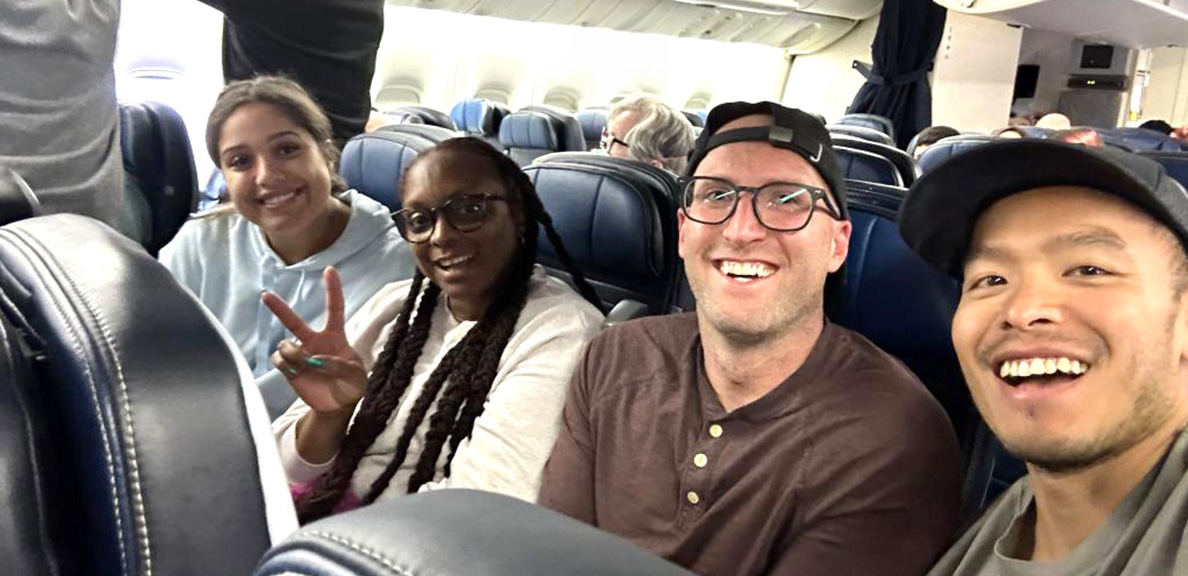
Flying High: How Three Graduate Students Plan to Modernize Air Traffic Control
BY Sam Balderas
July 6, 2023
Of the many opportunities students can find at Cal State East Bay, among them are challenges free from the pressure of a graded course. One example of this, and the success you can find when you give it a shot, is the FAA-TFM-AID. This challenge, available to college students across the country and hosted by the Federal Aviation Administration (FAA), stands for the Federal Aviation Administration Traffic Flow Management Application Integration Design Challenge. The goal? To design the new layout for the FAA’s traffic flow manager, a system meant to manage all the different factors required to keep planes in the air and landing smoothly, with less strain for the air traffic controllers.
Of the finalists of this challenge, three of Cal State East Bay’s own Pioneers were chosen to present their work, known as the AVA dashboard, in Washington D.C. on June 28. To tell us more about the challenge and the impact it can have, we talked with the group, led by Associate Professor of Art Ian Pollock and composed of the graduate student creators Ferdi Augusta, Jonathan Crescenzo and Patrice Reynolds. Together, they are hoping to create the newest flight management system which the FAA may use across the country.
So what is the point of this challenge? According to Pollock, to reduce cognitive load and stress. Air traffic controllers are commonly considered to have one of the most stressful jobs in the world and, due to this, their cognitive abilities begin to decline. According to the US Bureau of Labor Statistics they are required to retire at 56 to prevent burnout. In the words of Crescenzo, “Their human component is good, their technology is just old. Currently, they have 50 different applications they have to open and work through and so the goal is to create one interface and integrate the information from all these different applications.''
The main problem with these systems is age. Pollock said, “Many of these systems are so complicated and archaic that what they are really looking for is an integrated graphic user interface. It's really about streamlining the decisions and reducing the amount of anxiety and stress.” Air traffic controllers are the people keeping planes from crashing, and allowing them to do their job easier makes our air traffic safer.
The final group, made up of three interaction design graduate students, began thanks to the promotion of the challenge by Pollock. Pollock explains, “digital design is solving access problems through visuals, interaction design goes deeper into that problem and how to make decisions on what you choose to look at, where you click and touch things. It's a more complex response to a design challenge. Also known as [User Experience]. We are in the art department, but we are a STEM discipline…Something not everyone realizes is that design is a very technical discipline that intersects with creativity and makes technical systems available to people.”
To accomplish this task for the FAA, the group had to undertake massive amounts of research, which, according to Crescenzo, took two full days, with only a week before the deadline remaining. Their task was made more difficult by the complexity of the system, which needed to keep track of multiple factors like weather and traffic, and put it all into a single management system. Once that was done, the group could do the real work, as Augusta told us, “After we understood the flow, we started to get a requirement of what does this system need? What they really want is to minimize training. If it's too complex, it takes a long time to train. So they needed a system that was easy to understand and easy to use.”
The group felt a great sense of importance in their work. According to the Bureau of Transportation, 674 million people flew within the United States in 2021. Their safety depends on accurate information from the FAA. Reynolds understood this, saying, “I was reflecting, how it was kind of a noble endeavor just entering this competition because flight affects everybody. Whether you travel or not we receive goods by air, we receive loved ones by air, there's so many ways it affects every person on the planet whether or not you're an active business traveler or vacation traveler.”
The real-world applications students can practice, as well as the inspiration for other students, is a major draw, adding, “As a learning experience to solve a challenge that's a real-world challenge is incredible learning, I think that’s the first benefit to the students. Other students benefit because they see it and it gives them something to think about.”
Currently, there is another challenge students can take on. Since the success of the FAA challenge, ten students decided to sign up for the Mercedes Benz Innovation Contest 2023, compared to four in the FAA challenge.
In the Mercedes group are Jonathan Crescenzo, Devin Baldwin, Maryam Alaeifard, Divya Mittal, Jon Tambaoan, Akhliesh Naidu and Kushal Sheshadri. The Mercedes Benz Innovation Contest challenges contestants to imagine the state of retail in 2039. There's a sense that you have everything to gain trying your hand at these challenges, since no grades are given.
The FAA group would also like to acknowledge the work of international student Maryam Alaeifardi, who was a major part of the project design early on but was unable to continue due to a technicality with the challenge’s rules.
Topics
Share this story